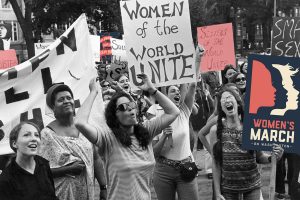The Women’s March on Washington was held on January 21st, 2017 in Washington D.C near the U.S. Capitol. The website states the event as a “grassroots effort comprised of dozens of independent coordinators at the state level”, with a mission statement as follows:
The March as a movement demands national attention to the idea that Women’s rights are human rights, “regardless of a woman’s race, ethnicity, religion, immigration status, sexual identity, gender expression, economic status, age or disability”. (https://www.womensmarch.com/mission/)
The three women who helmed the movement were titled as the “National Co-chairs” of the March. They are Tamika D. Mallory, a renowned social justice activist and New York City-based consultant, Carmen Perez, civil rights activist and Director of nonprofit “The Gathering for Justice” that seeks to build alternatives to incarceration and violence, and Linda Sarsour, a Palestinian-American-Muslim racial justice and civil rights activist and “social media maverick”. (https://www.womensmarch.com/team)
The March’s homepage states that  aside from the main Women’s March on Washington, there were 673 “Sister Marches” that were held all around the United States and the world, with a total of 4,956,422 attendees. (https://www.womensmarch.com/sisters)
aside from the main Women’s March on Washington, there were 673 “Sister Marches” that were held all around the United States and the world, with a total of 4,956,422 attendees. (https://www.womensmarch.com/sisters)
The demands of the March are plain and simple: affordable birth control, equal pay and healthcare equality for transgender Americans. The movement and March was sparked by the election of Donald Trump as president in the 2017 Presidential Election and the various threats to Women’s rights that followed.
The Guiding Vision and Definition of Principles of the March simplifies the goals of the movement to the following (abridged and reworded for brevity). Find the original document here.
- Gender Justice = Racial Justice = Economic Justice
- Women have the right to live a life free of violence to our bodies.
- Justice for Police Brutality, Sexual Assault and Racial profiling against all women of color and Indigenous people.
- Dismantling the gender and racial inequalities against women in the Criminal Justice system and preventing sexual violence against incarcerated women.
- Promotion of Reproductive Freedom and fighting against any form of federal, state or local restrictions on all women’s ability to access reproductive healthcare, birth control, family planning, abortion and STI/HIV prevention.
- Standing in solidarity with LGBTQIA individuals and demanding equal treatment in healthcare for these individuals with full anti-discrimination protection regardless of gender identification
- Equal pay for equal work and workplace anti-discrimination against indigenous women, lesbian, queer and trans women
- Domestic and Farm workers have the right to a living minimum wage. Sex workers must be included in labor protections. Exploitation for sex and labor is a violation of human rights.
- We must seek to break barriers and stand in solidarity with women with disabilities.
- We seek an all-inclusive amendment to the 14th Amendment, as the current amendment does not serve to guarantee equity on the basis of race and/or sex. This will be referred to as the “Equal Rights Amendment to the U.S Constitution” and will guarantee equal rights without regards to race or gender, with each citizens’ vote counting equally.
- Immigrants and refugees deserve equal treatment regardless of status or country of origin and should not be subject to mass deportation, family detention or violation of due process. Migration is a human right and no human being is illegal.
- Every person in the United States deserves access to clean water, clean air, and public lands. We demand that our land and natural resources be preserved and protected from corporate exploitation.
- We must stand in arms to fight aggression caused by a war economy and fight back to a select party of wealth that use their political, social and economic influence for their personal agenda.
Source: Women’s March on Washington. Guiding Vision and Definition of Principles. Women’s March on Washington. N.p., n.d. Web. 02 Apr. 2017.
Other cited sources:
“Mission & Vision.” Women’s March on Washington. N.p., n.d. Web. 02 Apr. 2017.
“March Committee.” Women’s March on Washington. N.p., n.d. Web. 02 Apr. 2017.
“Sister Marches.” Women’s March on Washington. N.p., n.d. Web. 02 Apr. 2017.
The Editorial Board. “What the Women’s March Stands for.” The New York Times. N.p., 20 Jan. 2017. Web. 02 Apr. 2017.


